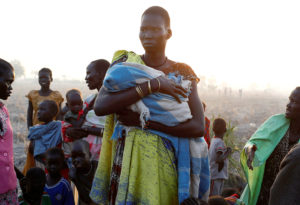South Sudan is the world’s youngest country, made up of 10 states, and home to over 60 different major ethnic groups. Salva Kiir Mayardit became president of South Sudan—then still part of Sudan—and head of the Sudan People’s Liberation Movement (SPLM) in 2005, succeeding long-time rebel leader John Garang, who died in a helicopter crash. Kiir was reelected in 2010. In 2011, when South Sudan became independent, he became president of the new state.
Independence did not bring conflict in South Sudan to an end. Civil war broke out in 2013 when Kiir suspected his then vice president Riek Macahr of instigating a failed coup. Since then, the conflict has displaced some 4 million people and led to the death of over 380,000 people, according to the London School of Hygiene and Tropical Medicine.
The origins and dynamics of the conflicts that have raged across South Sudan differ dramatically. At the war’s outset, there were two main warring parties: the government and its allies on one hand, and the Sudan Peoples’ Liberation Movement/ Army-In Opposition (SPLM/A-IO) on the other. Despite the signing of a power sharing agreement in August 2015, the conflict has continued to evolve, with opposition groups simultaneously factionalizing and localizing. There was relative peace for about a year until a spike in violence in July 2016 led Machar to flee the capital and declare the peace deal dead.
Many of the worst humanitarian situations occur in areas with ongoing conflict, where civilians are often deliberately targeted, thus creating the conditions for famine. Warring parties tend to view civilians as integral elements of their enemy’s economic, political and social support system. This is particularly evident during incidents of revenge violence, when civilians are likely to be treated not as distinct and protected but as part of an armed group. Following government combat operations or ambushes against government vehicles, it is common for soldiers to turn on local civilians. Rebels have also attacked civilians belonging to different ethnic communities.
Conflict exploded in Juba in July 2016. In response, international actors struggled to influence internal peace and conflict dynamics. There are no simple solutions in South Sudan, and moves towards genuine peace require compromises both among South Sudanese and between international actors and the government. Given the multiplicity of factions, peace is more likely to develop at the local level, whereby progress in some areas may occur at the same time as regression in others.
In August 2018, after five years of civil war, Kiir signed a power-sharing agreement with rebel leader Machar and other opposition groups in an attempt to end the brutal protracted conflict. The deal, which paves the way to a final peace accord, was signed in the presence of Sudanese President Omar al-Bashir and his counterparts from Kenya, Uganda, and Djibouti. Once a final peace deal is signed, the two sides will have three months to form a transitional government, which will take into effect for a further 36 months. The deal stipulates that there will be 35 ministers in the bloated transitional government, including 20 Kiir allies and nine backers of Machar along with representative of other rebel factions.


